Country
Crash of a Convair CV-580 in La Grande-4
Date & Time:
Sep 27, 2000 at 1038 LT
Registration:
C-GFHH
Survivors:
Yes
Schedule:
Montreal – Rouyn – La Grande-3 (LG-3) – La Grande-4 (LG-4) – Montreal
MSN:
109
YOM:
1953
Flight number:
APZ180
Crew on board:
3
Crew fatalities:
Pax on board:
18
Pax fatalities:
Other fatalities:
Total fatalities:
0
Captain / Total hours on type:
6000.00
Copilot / Total hours on type:
4000
Aircraft flight hours:
78438
Circumstances:
The Hydro-Québec Convair 340 (580), registration C-GFHH, serial number 109, with 18 passengers and 4 crew members on board, made an instrument flight rules flight from La Grande 3 to La Grande 4, Quebec. The aircraft touched down on the snow-covered runway at La Grande 4 approximately 800 feet beyond the runway threshold. Shortly after the nose wheel touched down and the pilot set the propellers to reverse pitch, the aircraft drifted to the right. Despite the attempts of the pilot flying (the captain) to correct, the aircraft continued its course and exited the south side of Runway 09 at approximately 50 knots. The aircraft travelled 350 feet over soft, rocky ground and came to rest about 120 feet outside the runway edge, about 2500 feet from the runway threshold. The flight crew followed the procedure to shut down the engines, but the left engine would not stop. On the captain's order, the first officer went into the passenger cabin and ordered an evacuation. All passengers exited the aircraft via the window emergency exits over the right wing. The left engine eventually shut down on its own after about 15 minutes. Five persons sustained minor injuries. The aircraft sustained substantial damage but did not catch fire.
Probable cause:
Findings as to Causes and Contributing Factors:
1. The steering control valve lever was not reassembled in accordance with the specifications and the drawings in the overhaul manual and the maintenance manual: the lever was assembled with two washers instead of one, and the circumference of the bushing was 0.0005 inch greater than the circumference of the hole in the lever. These two deficiencies created additional resistance that
impeded the pivoting of the aircraft steering wheel.
2. The nylon locknuts were reinstalled during the repair of the steering control valve, contrary to the recommendation that they be used only once. The locknuts then came loose in service, creating play in the parts of the valve.
3. Incorrect interpretation of the problem and the influence of previous experience using the nose-gear steering wheel led the crew to make the flight despite their concern about the aircraft's nose-gear steering system.
Findings as to Risk:
1. The maintenance personnel of Precision Aero Components Inc. used the (incomplete) maintenance manual instead of the overhaul manual to overhaul and repair the steering control valve,
contributing to the incorrect reassembly of the valve.
2. The steering control valve lever was not fitted with a grease fitting, and the outside of the bushing was not grooved to allow adequate lubrication, thereby risking corrosion and seizure of the bushing inside the lever.
3. The limited experience and the lack of formal training of the maintenance personnel concerning the repair and the overhaul on the steering control valve might have contributed to the incorrect
reassembly of the steering control valve.
4. The pilot flying cut the electrical power, as required by the hard landing procedure. The left engine could therefore not be shut down, causing a risk of injury when the passengers evacuated.
5. The pilot flying cut the electrical power after the aircraft exited the runway, as required by the hard landing procedure. The electrical power required to operate the public address and alarm systems was thereby lost, and the evacuation could not be ordered promptly.
6. The evacuation slide automatic deployment system was inadvertently deactivated, which could have delayed the evacuation and compromised passenger safety.
7. After separating from the engine, the left propeller blades entered the fuselage and damaged an unoccupied seat.
Other Findings:
1. The numerous changes in ownership of the Convair type certificate and the lack of technical support from the current holder caused maintenance problems for Convair operators and approved
maintenance organizations (AMOs), particularly for recently established AMOs.
1. The steering control valve lever was not reassembled in accordance with the specifications and the drawings in the overhaul manual and the maintenance manual: the lever was assembled with two washers instead of one, and the circumference of the bushing was 0.0005 inch greater than the circumference of the hole in the lever. These two deficiencies created additional resistance that
impeded the pivoting of the aircraft steering wheel.
2. The nylon locknuts were reinstalled during the repair of the steering control valve, contrary to the recommendation that they be used only once. The locknuts then came loose in service, creating play in the parts of the valve.
3. Incorrect interpretation of the problem and the influence of previous experience using the nose-gear steering wheel led the crew to make the flight despite their concern about the aircraft's nose-gear steering system.
Findings as to Risk:
1. The maintenance personnel of Precision Aero Components Inc. used the (incomplete) maintenance manual instead of the overhaul manual to overhaul and repair the steering control valve,
contributing to the incorrect reassembly of the valve.
2. The steering control valve lever was not fitted with a grease fitting, and the outside of the bushing was not grooved to allow adequate lubrication, thereby risking corrosion and seizure of the bushing inside the lever.
3. The limited experience and the lack of formal training of the maintenance personnel concerning the repair and the overhaul on the steering control valve might have contributed to the incorrect
reassembly of the steering control valve.
4. The pilot flying cut the electrical power, as required by the hard landing procedure. The left engine could therefore not be shut down, causing a risk of injury when the passengers evacuated.
5. The pilot flying cut the electrical power after the aircraft exited the runway, as required by the hard landing procedure. The electrical power required to operate the public address and alarm systems was thereby lost, and the evacuation could not be ordered promptly.
6. The evacuation slide automatic deployment system was inadvertently deactivated, which could have delayed the evacuation and compromised passenger safety.
7. After separating from the engine, the left propeller blades entered the fuselage and damaged an unoccupied seat.
Other Findings:
1. The numerous changes in ownership of the Convair type certificate and the lack of technical support from the current holder caused maintenance problems for Convair operators and approved
maintenance organizations (AMOs), particularly for recently established AMOs.

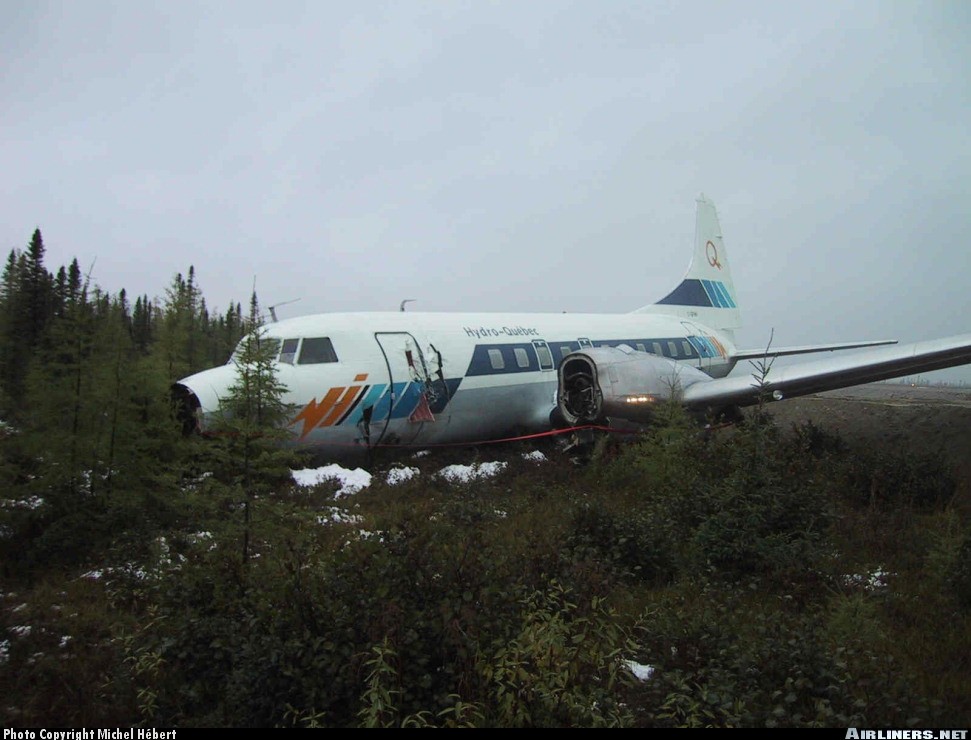
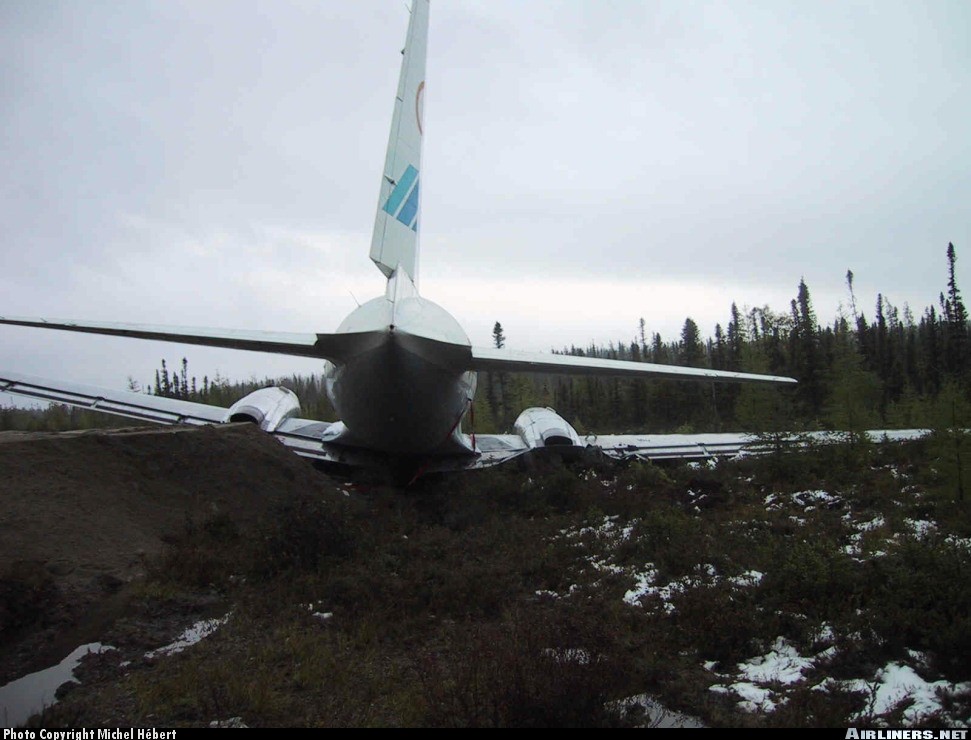
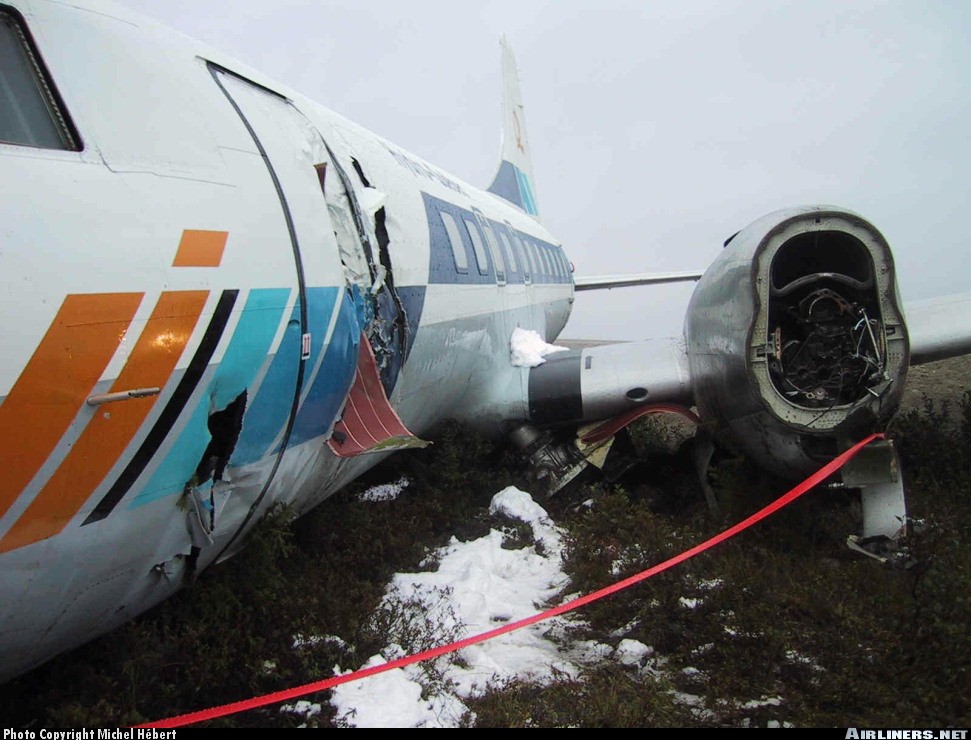
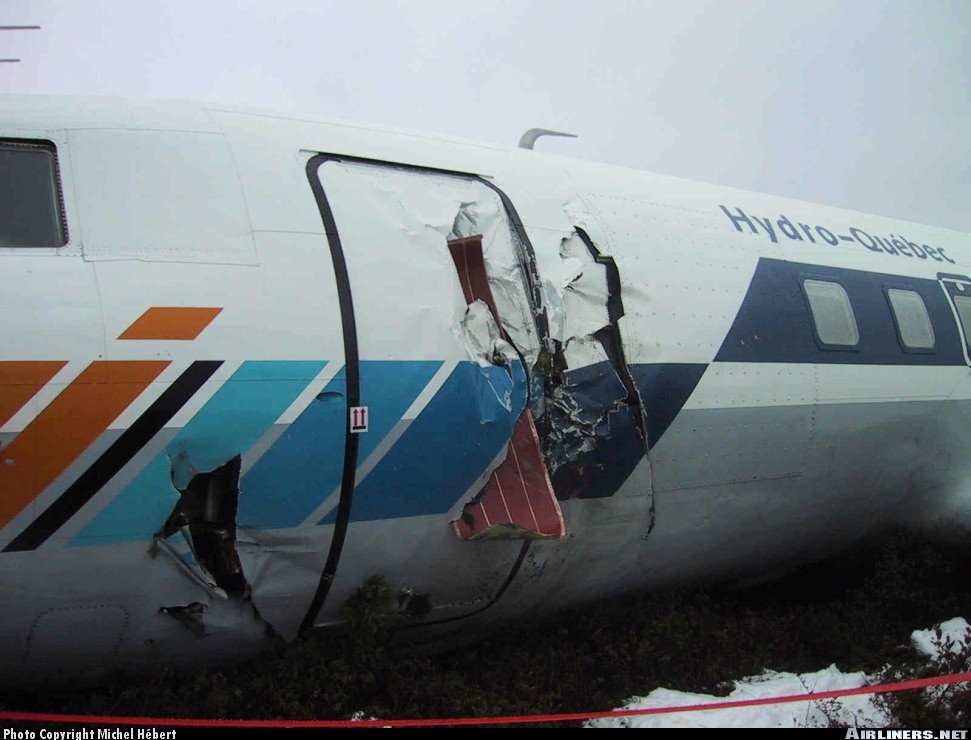
Crash of a Convair CV-580 in Tshikapa
Date & Time:
Nov 18, 1999
Registration:
9Q-CEJ
Survivors:
Yes
Schedule:
Tshikapa - Kananga
MSN:
79
YOM:
1953
Crew on board:
3
Crew fatalities:
Pax on board:
0
Pax fatalities:
Other fatalities:
Total fatalities:
0
Circumstances:
After takeoff from Tshikapa Airport, while in initial climb, both engines failed simultaneously. The aircraft stalled and crash landed in a field past the runway end and came to rest. All three crew members escaped with minor injuries while the aircraft was damaged beyond repair.
Probable cause:
Failure of both engines during initial climb due to a fuel exhaustion. It was determined that the aircraft had not been refueled prior to departure.
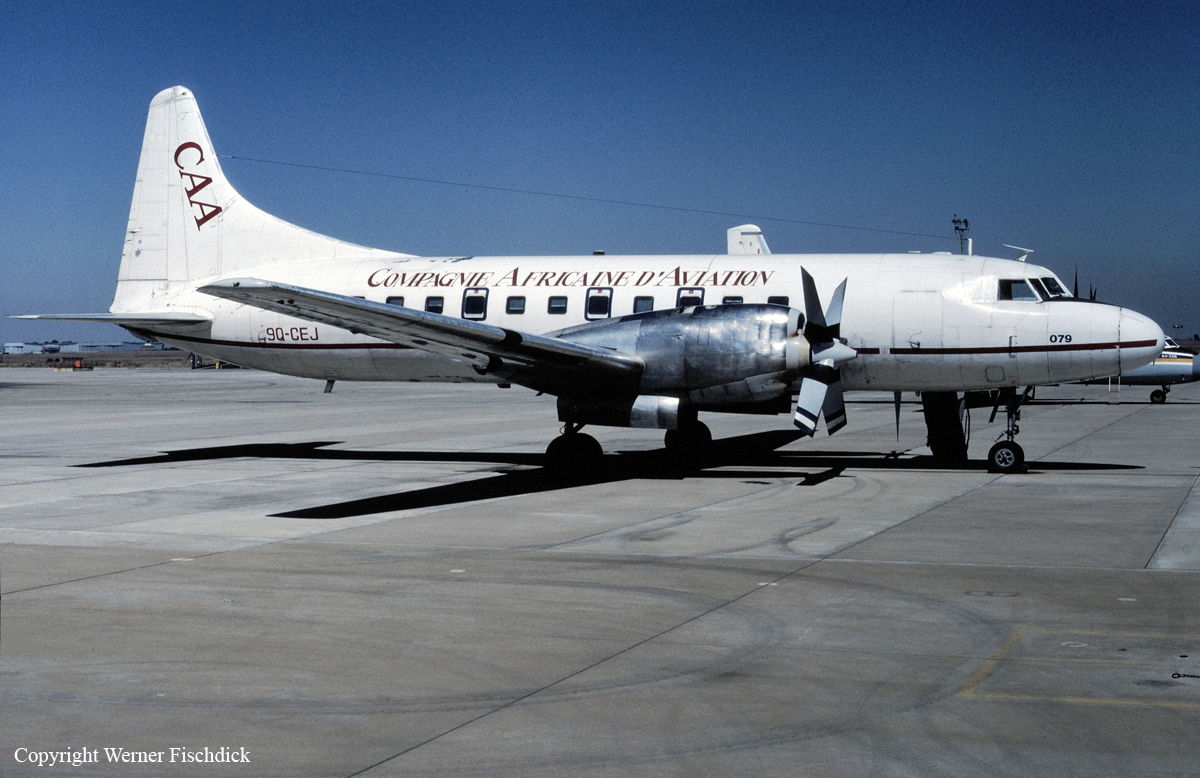
Crash of a Convair CV-580 in Tshikapa
Date & Time:
Apr 1, 1997
Registration:
9Q-CRU
Survivors:
Yes
Schedule:
Kinshasa – Tshikapa – Mbuji-Mayi
MSN:
41
YOM:
1967
Crew on board:
4
Crew fatalities:
Pax on board:
10
Pax fatalities:
Other fatalities:
Total fatalities:
0
Circumstances:
During the takeoff roll, the captain heard a noise and suspected a technical problem so he decided to abandon the takeoff procedure. Unable to stop within the remaining distance, the aircraft overran and struck an embankment. All 14 occupants escaped uninjured while the aircraft was damaged beyond repair. It was reported that the crew initiated the takeoff in an up-slope configuration while the takeoffs at Tshikapa Airport are normally completed in a down-slope configuration. The runway is 1,000 metres long.
Crash of a Convair CV-580F in Vitoria
Date & Time:
May 19, 1995 at 1839 LT
Registration:
EC-899
Survivors:
Yes
Schedule:
Vitoria - Vitoria
MSN:
354
YOM:
1956
Crew on board:
2
Crew fatalities:
Pax on board:
2
Pax fatalities:
Other fatalities:
Total fatalities:
0
Circumstances:
The crew was completing a local training mission at Vitoria Airport. In good weather conditions, the crew was approaching the airport in a flapless configuration when an alarm sounded in the cockpit. The crew turned off the circuit breaker so the alarm stopped. The aircraft landed on its belly and slid for few dozen metres before coming to rest. All four occupants escaped uninjured and the aircraft was damaged beyond repair.
Probable cause:
The aircraft belly landed after the crew failed to follow the approach checklist and turned off the circuit breaker.
Crash of a Convair CV-580 in Espinal
Date & Time:
Apr 8, 1995 at 1630 LT
Registration:
HK-3675
Survivors:
Yes
Schedule:
Espinal - Bogotá
MSN:
214
YOM:
1954
Crew on board:
4
Crew fatalities:
Pax on board:
0
Pax fatalities:
Other fatalities:
Total fatalities:
0
Captain / Total hours on type:
50.00
Copilot / Total hours on type:
8
Aircraft flight hours:
28843
Aircraft flight cycles:
8030
Circumstances:
The aircraft had been stolen in December 1992 and was later found abandoned at Espinal Airfield. SEC Colombia bought it and completed an in-site C1 check before transferring it to Bogotá-El Dorado Airport. While taking off from runway 26 ( gravel strip of 1,010 metres long), the aircraft deviated to the left and failed to lift off. It overran, crossed a road and came to rest 275 metres further, bursting into flames. All four crew members were able to escape and were uninjured while the aircraft was destroyed by fire.
Probable cause:
It was determined that the gravel runway 26 at Espinal Airfield was inappropriate for such type of aircraft. The runway was certified for agricultural aircraft with a maximum takeoff weight of 4,400 pounds while the Convair's takeoff weight was 38,888 pounds. The probable cause of this accident was the decision of the crew to take off from a runway unfit for this flight, finding a lack of performance on the soft surface, which prevented it to reach the VMCA, V1, VR, V2 speeds. The authorization by the company SEC to carry out a takeoff from a runway unfit for the flight was considered as a contributing factor.


